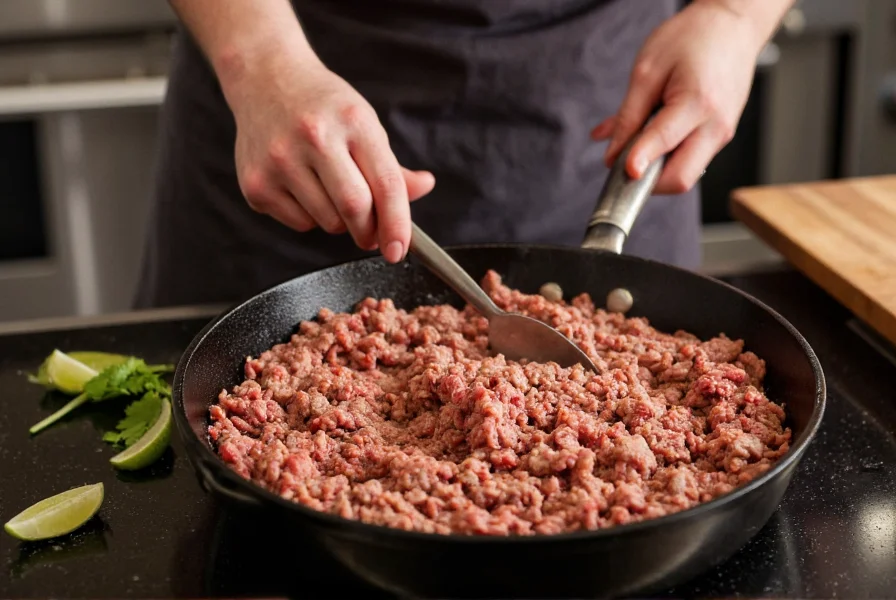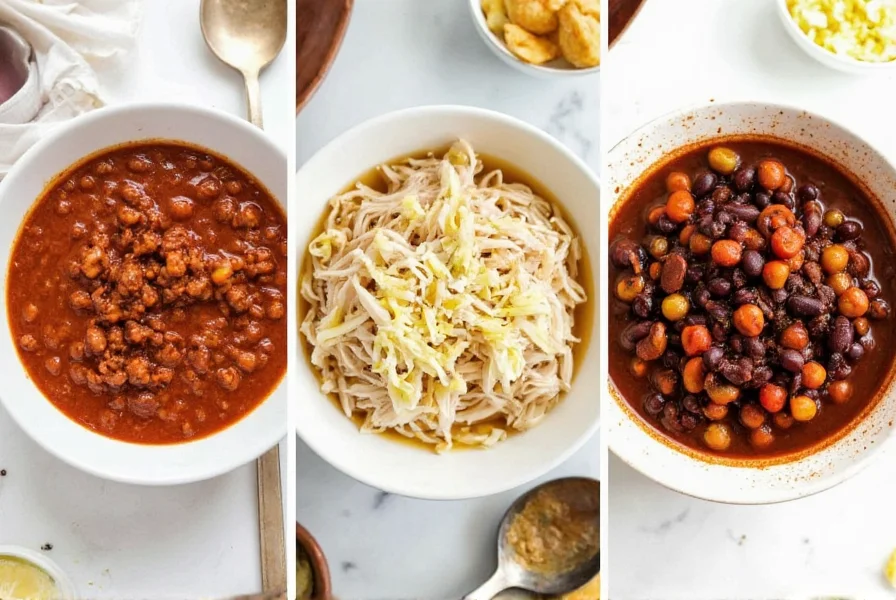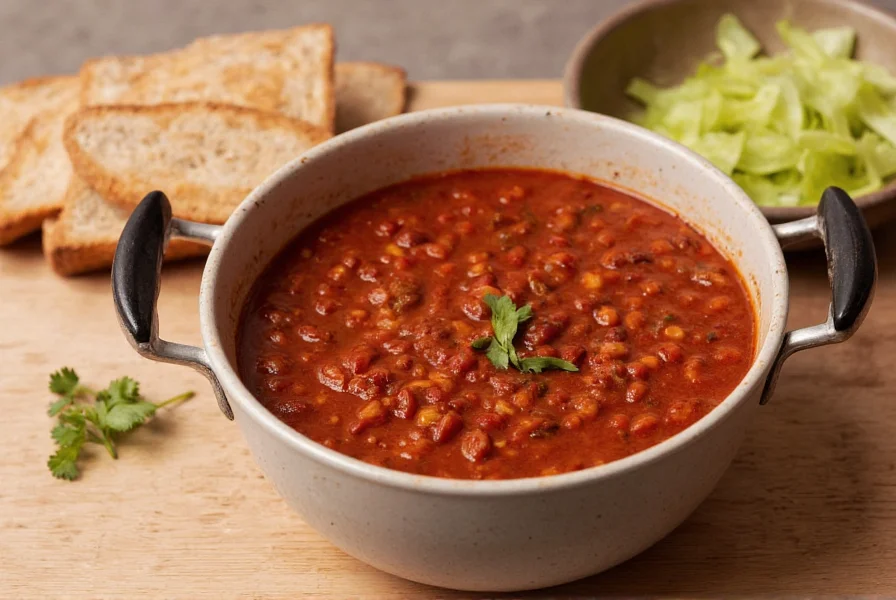Making exceptional chili isn't just about following a recipe—it's understanding the techniques that transform simple ingredients into a complex, satisfying dish. Whether you're preparing chili for game day, a family dinner, or meal prep, these professional techniques will elevate your results from ordinary to extraordinary.
Essential Ingredients for Flavorful Chili
The foundation of great chili begins with quality ingredients. While regional variations exist, certain components consistently deliver superior results:
| Ingredient Category | Recommended Options | Why It Matters |
|---|---|---|
| Meat | 80% lean ground beef, cubed chuck roast, or combination | Fat content provides richness; chuck adds texture and depth |
| Beans | Kidney, pinto, or black beans (optional depending on tradition) | Adds heartiness and texture; omit for Texas-style chili |
| Tomatoes | Canned fire-roasted tomatoes + tomato paste | Acidity balances richness; paste adds concentrated flavor |
| Spices | Toast whole cumin seeds, chili powder, smoked paprika | Toast spices to unlock essential oils and deepen flavor profile |
Professional Techniques for Perfect Chili Every Time
Proper Meat Preparation
Many home cooks make the critical error of dumping raw meat directly into the pot with other ingredients. Instead, follow this professional approach for how to make good chili with deep flavor:
- Pat meat dry with paper towels before browning
- Brown in batches to avoid steaming—this develops the Maillard reaction
- Remove browned meat and deglaze the pot with beer or broth to capture flavorful fond
- Return meat to the pot after building your flavor base
Spice Toasting Method
One of the most overlooked steps in how to make flavorful chili from scratch is properly preparing your spices. Toasting whole spices before grinding releases their essential oils:
- Heat a dry skillet over medium heat
- Add whole cumin seeds and toast until fragrant (about 2 minutes)
- Grind with other dried spices using a mortar and pestle or spice grinder
- Add spices to the pot after sautéing onions and garlic, cooking for 1-2 minutes to bloom in the fat

Step-by-Step Cooking Process
Building Flavor Layers
Creating exceptional chili requires patience and attention to the sequence of adding ingredients. Follow this timeline for optimal results when learning how to make good chili:
- 0-15 minutes: Brown meat in batches, removing each batch as it finishes
- 15-25 minutes: Sauté onions, garlic, and bell peppers until caramelized
- 25-28 minutes: Add toasted spices and cook for 2 minutes to bloom
- 28-30 minutes: Stir in tomato paste and cook until it darkens slightly
- 30-35 minutes: Deglaze with ½ cup beer or beef broth, scraping up browned bits
- 35-40 minutes: Add remaining ingredients except chocolate/sweetener
- 40-130 minutes: Simmer uncovered, stirring occasionally
- 130 minutes: Stir in 1 oz dark chocolate or 1 tbsp brown sugar
- 130-150 minutes: Final simmer to meld flavors
Common Mistakes That Ruin Chili
Avoid these frequent errors when making how to make authentic chili at home:
- Skipping the meat browning step: Results in gray, boiled meat without depth
- Adding spices raw: Creates harsh, one-dimensional flavor
- Not simmering long enough: Flavors remain separate rather than melding
- Over-relying on canned chili seasoning: Often contains excessive salt and fillers
- Adding beans too early: Causes them to break down completely
Variations for Different Preferences
Once you've mastered the basic technique for how to make good chili, experiment with these authentic variations:
Texas-Style Chili (Chili con Carne)
Omit beans and tomatoes for a meat-forward chili that highlights the quality of your beef and spice blend. Use only dried chilies rehydrated and blended into a paste for authentic flavor.
White Chicken Chili
Substitute chicken for beef, use white beans instead of kidney beans, and incorporate green chilies and tomatillos for a lighter, tangier profile.

Storage and Reheating for Maximum Flavor
Chili often tastes better the next day as flavors continue to meld. For best results:
- Cool completely before storing in airtight containers
- Refrigerate for up to 4 days or freeze for up to 3 months
- When reheating, add a splash of broth or water to restore moisture
- Always reheat to 165°F (74°C) for food safety
Professional chefs note that chili develops more complex flavors after 24-48 hours in the refrigerator. The fat molecules break down and redistribute, creating a more integrated taste profile—this is why many chili competitions require entries to be made at least one day in advance.
Final Expert Tips for Perfect Chili
Before serving your chili, implement these finishing techniques that distinguish how to make good chili from merely adequate:
- Balance acidity with a splash of apple cider vinegar if needed
- Add richness with a tablespoon of masa harina stirred in during the last 15 minutes
- Adjust heat level with cayenne rather than more chili powder to avoid overwhelming other flavors
- Let chili rest for 15 minutes before serving to allow flavors to settle
- Serve with cooling accompaniments like sour cream or avocado to balance heat
How long should I simmer chili for optimal flavor development?
For the best results when learning how to make good chili, simmer for at least 90 minutes. Professional chefs recommend 2-3 hours for flavors to fully meld. The extended cooking time allows connective tissues in the meat to break down and flavors to integrate completely. Avoid boiling vigorously—maintain a gentle simmer to prevent scorching.
What's the secret ingredient that makes chili taste restaurant-quality?
The professional secret for how to make flavorful chili from scratch is adding 1 ounce of 70% dark chocolate during the last 15 minutes of cooking. The cocoa solids enhance richness without making the chili taste sweet, while the bitterness balances the acidity of tomatoes. Alternatively, 1 tablespoon of brown sugar can provide similar balancing effects for those who prefer to avoid chocolate.
Can I make good chili without beans?
Yes, authentic Texas-style chili (chili con carne) contains no beans. Beans were traditionally added as a filler and aren't part of the original recipe. For how to make authentic chili, focus on high-quality meat, properly toasted spices, and a long simmer. If you prefer texture, consider adding diced potatoes instead of beans for a similar heartiness without altering the traditional flavor profile.
How can I fix chili that's too spicy?
If your chili is too spicy when learning how to make good chili, add dairy (sour cream or shredded cheese), a touch of sweetness (honey or brown sugar), or acidic elements (lime juice or vinegar). You can also increase the volume by adding more tomatoes, beans, or broth. Never add more heat once you've over-spiced—always adjust gradually throughout the cooking process by tasting frequently.
What's the best cut of beef for making chili from scratch?
For how to make good chili with superior texture and flavor, use a combination of 80% lean ground beef and 1-2 pounds of cubed chuck roast. The ground beef provides immediate flavor, while the chuck roast breaks down during the long simmer, adding richness and texture. Avoid leaner cuts like sirloin which can become dry during extended cooking. The fat content is essential for carrying the fat-soluble flavor compounds in your spices.











 浙公网安备
33010002000092号
浙公网安备
33010002000092号 浙B2-20120091-4
浙B2-20120091-4